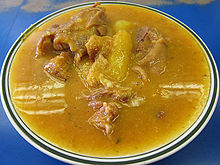- Sopa de mondongo
-
Sopa de mondongo is a soup made from slow-cooked diced tripe (the cleaned stomach of a cow) and, vegetables such as bell peppers, onions, carrots, cabbage, celery, tomatoes, cilantro, garlic or root vegetables originating from Latin America and the Caribbean.
Variations
Many variations of sopa de mondongo exist in Latin America and the Caribbean. Some add rice or maize late in the process. Bone marrow or hoof jelly may be used. The tripe may be soaked in citrus juice or a paste of sodium bicarbonate before cooking. The vegetables and spices used vary with availability. Origins of mondongo can be tracked back to African slaves in the Dominican Republic and Puerto Rico.
In Brazil, it is also referred to as mondongo. It is usually consumed in the southern regions, but in northeast it is also named dobradinha.
In Colombia sopa de mondongo is often eaten as the soup course of a traditional almuerzo. The soup in Colombia, is often made with chicken or beef stock, with a lot of cilantro. Many vegetables such as peas, carrots and onion are used to flavor the chicken or beef stock. Salt and pepper, along with corn, are also thrown into the soup for extra flavoring. The tripe used for this soup is varied. The most typical kind of tripe is beef tripe, but in several other regions across the nation, pork tripe and chicken or turkey tripes are also used in the soup.
In Panama it is cooked as a stew with chorizo, and chickpeas and is considered a heavy meal, traditionally it is served when a roof is installed on a new house. The construction workers and the future owners along with their family and friends share the meal together in what is known as a "mondongada".
In Puerto Rico it is cooked with chickpeas, potato, squash/pumpkin, malanga, vegetables, fresh herbs such as cilantro, culantro, thyme and parsley. Salted pork feet and tail are also added. Lemon juice, green or sweet plantains, green banana, capers, olives and other root vegetables like cassava are also very common.
In El Salvador, it is also referred as "sopa de pata" is considered a very nutritious and tasty food. It is cooked with ripe banana, cabbage leaves, cassava,sesame seeds, pumpkin seeds, carrots, potatoes, huisquil, green chile, udder or beef tripe, onion and cow’s feet.
In Venezuela, it is usually referred to as just mondongo and is considered a very heavy meal, often reserved as a single meal of the day. It is usually consumed in the north-central regions and in the llanos, and depending of the region, it may turn more sweet (as in the eastern coast) or having chickpeas, but a common characteristic that all have, is the adding of beef legs to increase and improve the taste, and is actually the ingredient that gives the mondongo its flavor and extra high chaloric content. The mondongo is often flavored with lemon or tamarind, and accompanied by arepas or casabe. Usually, in the whole Venezuelan territory, the mondongo is eaten by the people at very early hours of the day, or late in the night, when they go out of the rumbas or parties in nightclubs. The mondongo, is also used to be sold in areperas or restaurant specialized in the making of arepas.
See also
Wikimedia Foundation. 2010.


